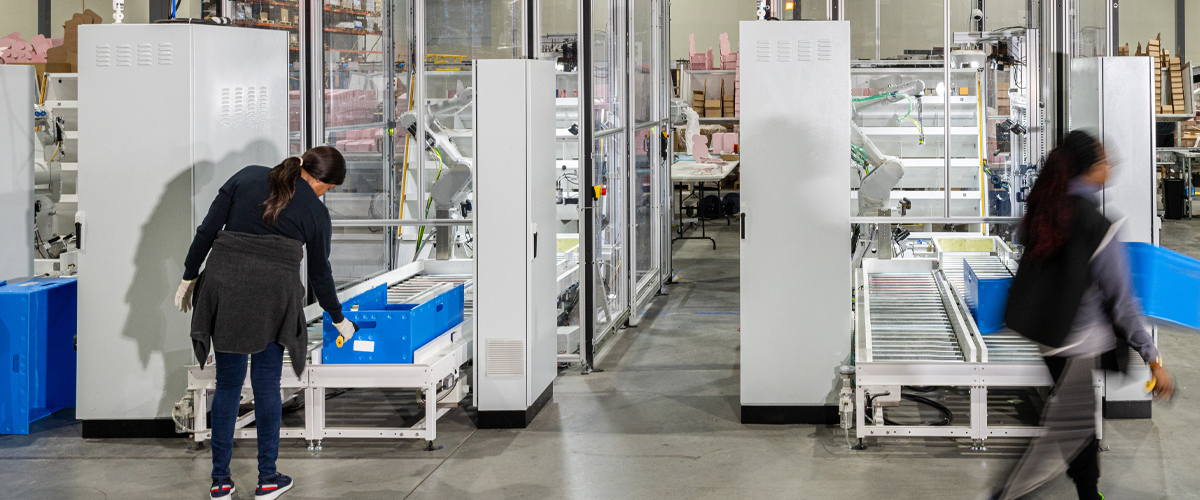

5 Third-Party Logistics/3PL Trends to Watch in 2023
As the world continues its drawn-out attempt to shake off post-pandemic supply chain constraints and the US economy grapples with inflationary headwinds, we face a challenging year ahead. Various 3PL trends represent an opportunity to rise to these challenges.
Despite those hurdles, the prospects for growth in certain sectors are surprisingly good and the need to reimagine supply chains offers opportunities to tackle longstanding problems, from labor commoditization to an unhealthy obsession with short-term results.
3PL Trends for the Year Ahead
Here are five trends in third-party logistics to watch out for in 2023:
- Adapted Automation
- Micro Fulfillment
- Assessing the Cost of 3PL Commoditization
- Layering in Appropriate Technology
- Long-term Logistics Partnerships
In the video above, our CSO Thom Campbell covers three of these trends that he expects to be especially influential. For a deeper dive into each individual trend, read on!
Adaptation of Automation
Deploying new technology on a regular cadence requires a significant investment in engineering team talent. These are highly qualified, sought-after positions operating to extremely tight project management constraints. These talents need to be focused and directed to make the most of their efforts.
In short, be extremely judicious when selecting the next piece of technology you want to implement.
For this reason, applicable adaptation of automation is increasingly a focus of ambitious brands who want to achieve significant growth in short order. To do this, the automation you choose should be driven by its impact on the experience of your customers and colleagues, rather than the latest and greatest warehouse toys.
For example, if you are really interested in miles and miles of conveyer and nice little robots that don’t improve the experience that happens at the other end, your investment appears impressive but may not deliver enough. Alternatively, if you elevate your people by applying automation to low-level, repetitive tasks, this investment empowers them to drive better customer outcomes.
A more considered approach to automation will yield long-term rewards and it's something we expect to see more of across 3PL trends in 2023.

Cost of Commoditization
For the first time in a long time, there has been something of a race to the bottom in terms of 3PL trends and what businesses across multiple sectors are willing to pay for fulfillment services. Revenues have grown during - and emerging from - the pandemic, leading to overconfidence that results would continue to be strong, even for brands that choose to skimp on fulfillment services.
The reality is that almost every brand suffers significant customer attrition when service and presentation levels decline, and the cost of rebuilding a formerly strong brand reputation is steep. This is the cost of treating labor and 3PL services as a commodity.
What we expect to see in 2023 is a realization that this gradual degradation of brand reputation is not worth the short-term savings. As orders arrive late, are poorly packaged, and driving increased returns, brands quickly understand that the declining service levels and inconsistent order experience of low-cost fulfillment sends customers running into the arms of competitors.
In a year where customer spending is expected to tighten and high inflation has consumers seeking value in every purchase they make, this is not the time to treat logistics and delivery functions as a commodity. Quite the opposite! We expect to see those brands that double down on long-term logistics partnerships bolster their reputation and build a strong foundation for scaling up once economic conditions improve.
Layering in Tech
Our industry started from a relatively low-tech place. A forklift truck here, a conveyer system there...maybe add some mechanized work, incorporate early IBM computers and evolve to the contemporary warehouse.
Fast forward to the modern day logistics facility and you have cloud-based technology, business software like Tableau, and complex tier-1 warehouse management tools that can integrate all kinds of automated equipment.
Layering in new technology has always been a trend in third-party logistics and we expect to see this continue throughout 2023. At Capacity, we keep implementing new technologies to facilitate automation and stay at the front of the pack.
Micro-fulfillment
Micro-fulfillment refers to the use of compact, highly automated warehouses that are typically located closer to a brand's key customer bases than their core distribution centers. The objective of micro-fulfillment centers is usually to speed up delivery times and reduce costs.
In line with several trends highlighted in this piece, robotics and automation contribute greatly to a micro-fulfillment facility's ability to pick, pack, and ship orders. They can also be integrated into existing stores, further enhancing the appeal for retailers with significant brick-and-mortar footprints (or brands with retail partnerships that they can leverage to the same effect).
In urban centers where you have high concentrations of customers, micro-fulfillment is attractive because you can offer a four-hour delivery time or below by setting up a few focused SKU bases.
While micro-fulfillment is a trend in its infancy across North America, it is out there and could accelerate in 2023, in part due to the continuing evolution of retail centers. It might become very popular, especially with fast fashion brands and in other product categories where customers value immediacy.
Long Term Logistics
Our final take on 3PL trends to watch in 2023 is also, we would argue, the most important. As with acknowledging the cost of commoditizing logistics and labor that we touched upon above, a move back to long-term partnerships would serve the sector well.
While keeping costs under control is undeniably important, engaging a true partner for your fulfillment and logistics yields several benefits over a more transactional service provider. These include:
- Flexibility: Long-term partners can work together to create customized logistics solutions that are tailored to a company's specific needs, providing greater flexibility and scalability.
- Improved communication and coordination: A long-term relationship allows for the development of strong communication channels and a deep understanding of each other's needs and capabilities, leading to improved coordination and problem-solving.
- Increased capacity: With a long-term partner, a company can take advantage of their larger network and resources to improve delivery times, increase capacity, and reach new markets.
- Improved service quality: By building a strong relationship with a logistics partner, a company can work together to improve service quality, reduce errors and increase visibility of the logistics process, increasing overall satisfaction.
- The ability to manage risks and ride out market fluctuations: Long-term partnerships allow for shared risk management and contingency planning, helping a company to better anticipate and mitigate potential risks to their supply chain. For example, warehouse space can become constrained, ramping up prices with every new 3PL provider. Being with a long-term partner aids transparency of cost and limits opportunistic price hikes.
Overall, a long-term logistics partnership can be a strategic move for companies looking to improve the efficiency, effectiveness and cost-effectiveness of their logistics operations.
What 3PL trends do you expect to see over the next 12 months?